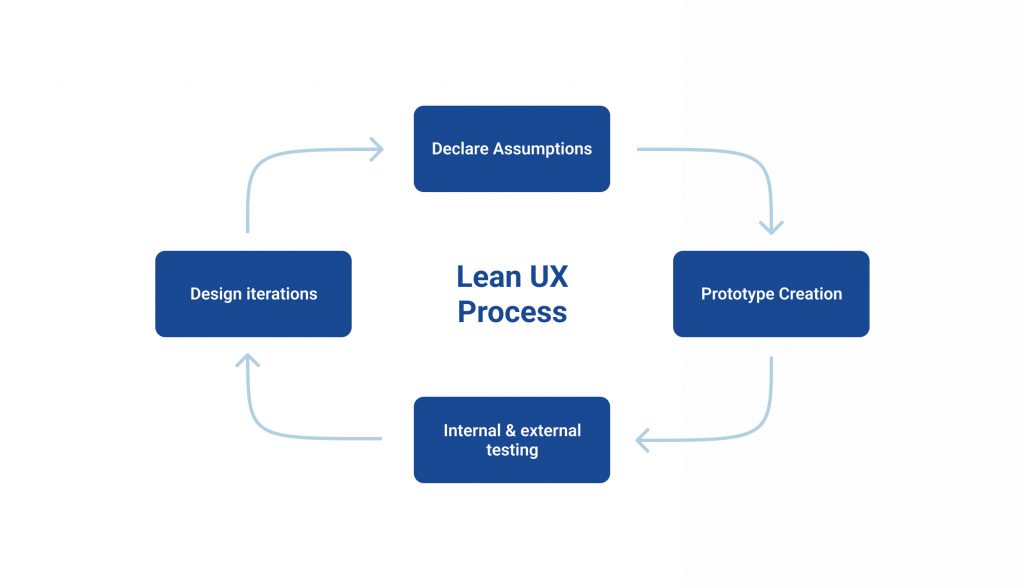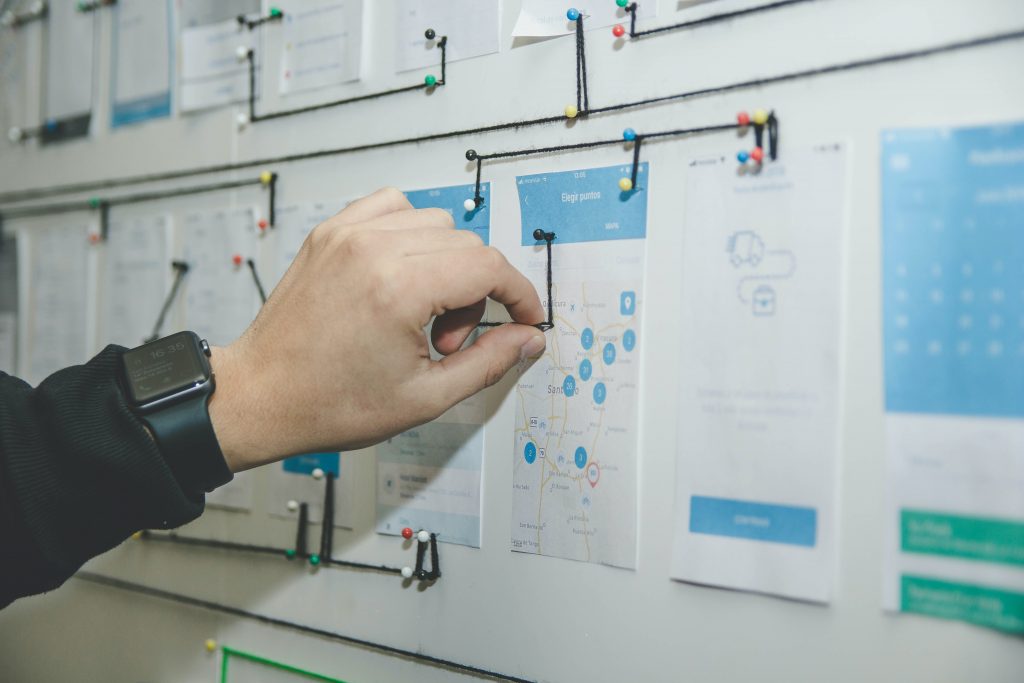Introduction to Lean UX
Lean UX is a dynamic, user-focused design approach that streamlines the traditional UX process by emphasizing speed, teamwork, and ongoing learning. It’s a fusion of design thinking, agile development, and lean startup principles. This methodology promotes rapid iterations with cross-functional teams, who work closely to progressively refine product designs. Instead of extensive documentation, Lean UX teams prioritize assumptions, hypotheses, and swift visual artifacts. Early and basic prototypes are preferred over detailed specifications.
The essence of Lean UX is collaboration. Designers, developers, and product owners don’t work in silos; they collaborate in fast-paced cycles. After setting initial hypotheses, the team crafts prototypes and conducts both internal and external tests. Real-time feedback then steers design enhancements in subsequent cycles.
The beauty of Lean UX lies in its efficiency. By testing concepts with actual users early on, teams can quickly identify and rectify issues. This approach minimizes waste, focuses on essential features, and ensures faster delivery of high-quality user experiences with reduced risk.
Core Principles of Lean UX
Lean UX is centered around a few key principles that optimize and streamline the design process.
Rapid Iterations and Testing
A core Lean UX principle is the rapid building of minimum viable prototypes that can be quickly tested. Prototypes are iterated frequently based on user feedback from continual testing. This fail fast, iterative approach allows teams to learn quickly and validate ideas with real users early and often. Frequent testing and iteration of prototypes enables rapid refinement of the user experience.
Minimal Documentation
Lean UX avoids heavy upfront design documentation and lengthy deliverables. The focus is on visual artifacts like sketches and diagrams that facilitate collaboration and shared understanding. Documentation is limited to capture key feedback and learnings from user testing. This minimal documentation approach prevent teams from getting bogged down in specifications and allows more time for actual design and testing.
Multidisciplinary Teams
Lean UX favors close cross-functional collaboration between designers, developers, product owners and other roles. Breaking down silos and promoting shared understanding across disciplines is key. A diversity of perspectives leads to better solutions focused on delivering the optimal user experience.
User-Centered Focus
The user experience is the top priority throughout the Lean UX process. Users are involved early and continuously to drive the design. The team builds empathy for users and let their feedback guide each design iteration. Data from testing with real users informs improvements and keeps the design truly user-centered.
Continuous Learning and Improvement
The tight feedback loop created by continual user testing enables continuous learning. The Lean UX team remains open to ambiguity and change based on the data gathered. Through this agile, iterative approach, the design evolves to best meet user needs.
The lean principles of Lean UX optimize the design process to be rapid, collaborative and user-focused. This creates a smooth flow of learning and improvements driven by the end-user experience.
Lean UX Process

The Lean UX process is centered around building and testing prototypes in rapid iterations. This lean approach follows a general framework:
- Assumptions and hypotheses
- Prototype creation
- Internal testing
- External user testing
- Design iterations
Starting with Assumptions
In the absence of detailed requirements, Lean UX starts with assumptions and hypotheses about the user and problem space. These are generated through collaborative workshops with the cross-functional team. Key questions are asked to frame the problem and elicite assumptions.
Prototype Creation
Using the assumptions as a guide, the team sketches concepts and builds initial prototypes. These minimal viable prototypes aim to test the riskiest parts of the concept quickly and cost-effectively. Simple prototypes might be paper sketches, wireframes, or basic software.
Internal and External Testing
The prototypes are put through realistic internal testing with the product team and external user testing with target users. The internal testing focuses on technical function while the external tests measure usability and user satisfaction.
Iterating the Design
The feedback from testing is synthesized to drive design improvements. The prototypes are then refined and re-tested. This build-measure-learn loop continues for several rapid iterations until the desired user experience is achieved.
Data-Driven Decisions
Throughout the cyclical Lean UX process, decisions are informed by data from real user feedback. Features and designs are added and removed based on test results rather than opinions and assumptions. This data-backed approach keeps the product aligned with user needs.
The Lean UX loop maximizes learning while minimizing waste. Rapid prototyping and iteration ultimately yields higher quality, user-validated experiences.
Keys to Successful Lean UX
Adopting Lean UX principles is only the first step. To fully realize the benefits, teams should also focus on these areas:
Reality-Based Testing

Success hinges on realistic testing with actual users. Feedback must come from a representative sample from the product’s target audience. Testing artificial concepts or getting feedback from internal team members defeats the purpose.
Real-world user perspectives are the lifeblood of Lean UX. Teams should conduct guerilla user testing, concept labs, A/B tests, and other experiments with real users often. Observing behaviors and emotions, not just preferences, yields insights.
The Right Team
A cross-functional team with a mix of skills in design, development, research, and business strategy is ideal. Collaboration between divergent viewpoints prevents biased decisions.Including user experience experts throughout the process is critical.
There should be no lone visionaries. Solutions should emerge from the team’s combined perspectives balanced with user feedback. A strong team with a shared vision and commitment to the process will excel.
Design-Driven Process
User experience design should be the north star guiding decisions. Lean UX remains focused on designing experiences people need and want, not just pushing technology forward.
Designers must be empowered to interpret user data and translate it into human-centered solutions. Every prototype should tell a story to test. Design brings coherence and purpose to Lean UX’s cyclical, iterative approach.
With the right team makeup, a solid UX design lead, and genuine user feedback driving development, Lean UX projects will deliver highly satisfiying user experiences efficiently.
Benefits of Lean UX
The iterative, user-centered Lean UX methodology offers several advantages over traditional UX approaches:
Faster Time to Market
By eliminating wasteful documentation and linear phasing, Lean UX compresses project timelines significantly. Teams can launch months or years earlier than with waterfall processes. The minimal viable product approach also accelerates learning and refinement.
Reduced Risk
Traditional UX has a higher chance of failure after months or years of misguided work. By testing concepts early and often with real users, Lean UX exposes issues while they are still small and easy to fix. Continual course corrections keep the project on track.
Increased User Satisfaction
Including user feedback throughout development instead of just at the end ensures the product solves real needs. The experience is tailored to user goals at every step, delighting users.
Cost Savings
Catching issues early prevents costly rework late in development. Eliminating excessive documentation and meetings also cuts costs. Lean UX delivers better experiences with less time and money wasted.
Quick Adaptation to Change
Markets and user needs rapidly evolve. Traditional UX struggles to pivot, while iterative Lean UX can quickly test and integrate new directions. Short sprints and continuous user input enable agility.
By focusing on collaborative, rapid experimentation and learning, Lean UX adds speed while improving quality and customer satisfaction.
Conclusion
Lean UX offers a modern approach to creating human-centered digital experiences efficiently. By following its lean principles, teams build better products faster.
Key tenets like rapid prototyping, MVPs, cross-functional collaboration, and continuous user testing enable agility and innovation. Driven by hard data instead of opinions, Lean UX stays focused on real user needs throughout development.
The methodology promotes failing fast and iterating quickly to maximize learning. Removing waste from bloated documentation and misguided features, Lean UX instills a bias for action and experimentation.
Adopting Lean UX requires a new mindset focused on solving problems, not generating deliverables. Designers, developers, product owners and users co-create solutions through an iterative loop of hypothesis-driven prototyping and feedback.
At B-works, we are experts in Lean UX. Our software development process leverages lean principles to create digital products perfectly tailored to user needs.
To adopt Lean UX, build cross-functional teams, align on problems, test ideas quickly, learn continuously, and focus on the user experience above all else. Improve odds of success with our services.
Lean UX speeds the path to delightful, valuable digital experiences both customers and organizations will love. To learn more, contact our UX experts today.
